How can we help?
Drawdown Risk Report
Available on Premium and Sharesight Business plans.
The drawdown risk report provides a comprehensive analysis of your portfolio by comparing each investment's performance to its maximum drawdown (MDD) over a specified period. It helps you to understand your current portfolio construction and helps inform potential rebalancing decisions to better align with your risk tolerance and investment strategy.
Our drawdown risk report summarises both the annualised total return and MDD for each investment. This allows for a side-by-side comparison of each asset's performance against its risk of drawdown, offering a clearer picture of your portfolio's risk profile and facilitating informed rebalancing decisions.
The report uses two primary metrics: MDD and the Return Over Maximum Drawdown (RoMaD) score, both explained in depth in subsequent sections. However, it is important to note some limitations of this analysis: it does not account for overall volatility, the frequency of losses, recovery speed, or the duration of drawdowns, and it excludes custom investments, cryptocurrencies, and FX assets. Additionally, results are sensitive to the chosen time period, potentially reflecting varying market conditions (e.g., bull versus bear markets).
Embedded content: https://www.youtube.com/watch?v=lZOIcsG1QaM
What is maximum drawdown (MDD)?
MDD represents the largest observed loss in a portfolio from a peak to a trough before reaching a new peak, serving as an indicator of downside risk over a specified period. Expressed as a percentage, MDD is calculated as:
MDD = (Trough Value−Peak Value) ÷ Peak Value
In the drawdown risk report, we calculate the MDD for each asset to assess its associated risk. Beyond risk assessment, MDD can also reflect market performance, providing insights into potential losses during adverse market conditions.
MDD is particularly relevant for long-term investments, where it is often used as a relative measure by comparing one portfolio's MDD to others or to a benchmark. MDD specifically measures the potential for loss, focusing on the risk of drawdown rather than market volatility.
It’s important to note that MDD is a backward-looking metric, relying solely on past performance without predicting future results. Therefore, MDD should not be the sole measure used when evaluating a portfolio’s performance.
What is Return Over Maximum Drawdown (RoMaD)?
RoMaD is a risk-adjusted performance metric that focuses on maximising returns while minimising the maximum drawdown (MDD), offering an alternative to the Sharpe or Sortino Ratios. Expressed as a decimal, RoMaD is calculated as:
RoMaD = portfolio return ÷ maximum drawdown
This metric combines portfolio returns with MDD based on asset prices, helping to optimise returns relative to the associated drawdown risk of each investment.
How to run Sharesight’s Drawdown Risk Report
Embedded content: https://www.youtube.com/watch?v=YzU203hqxDU
1 — From any page click on the ‘Report’ tab.
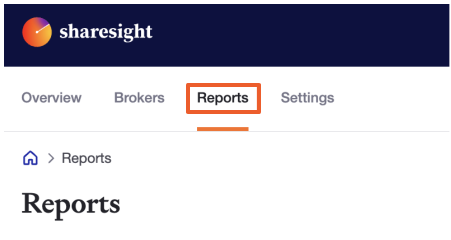
2 — Under the asset allocation reports, click the ‘Drawdown Risk’ tile.

3 — Select the maximum drawdown period
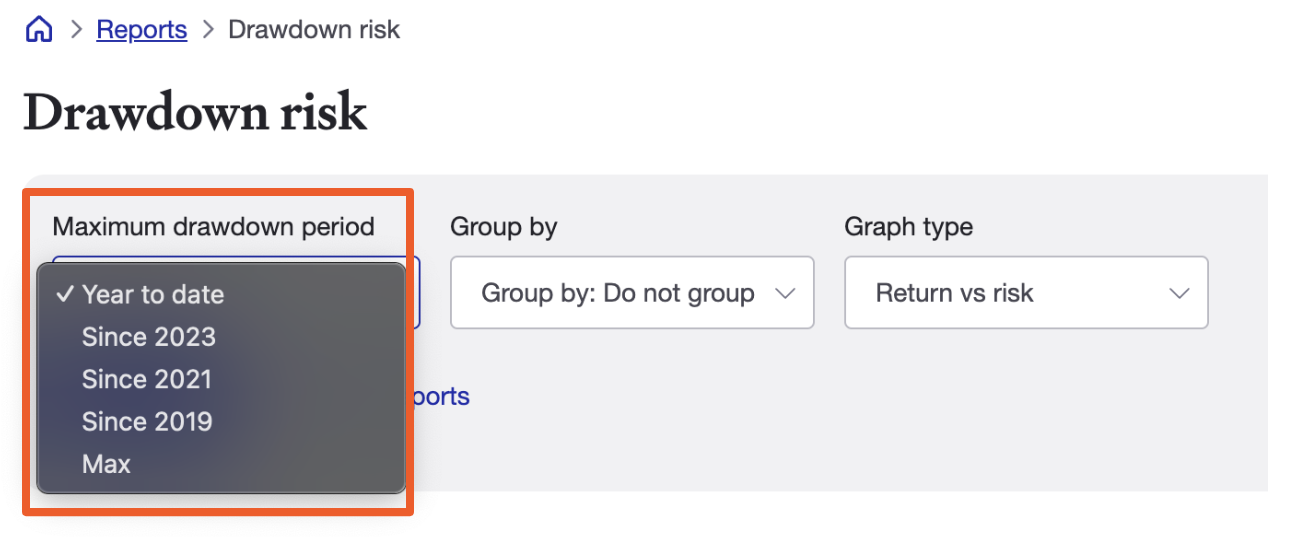
4 — Select the grouping you wish to view the report

5 — Click on ‘run report’ button.
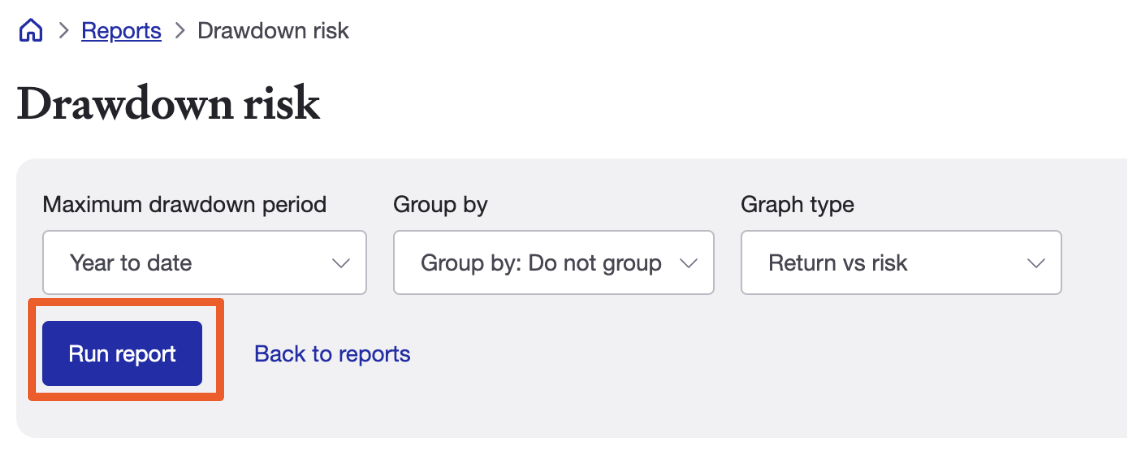
Drawdown risk report graph and summary overview
The graph
The report presents all your investments on a graph, with each investment sized according to its current value. Returns are plotted on the Y-axis from lowest to highest, and MDD is plotted on the X-axis.
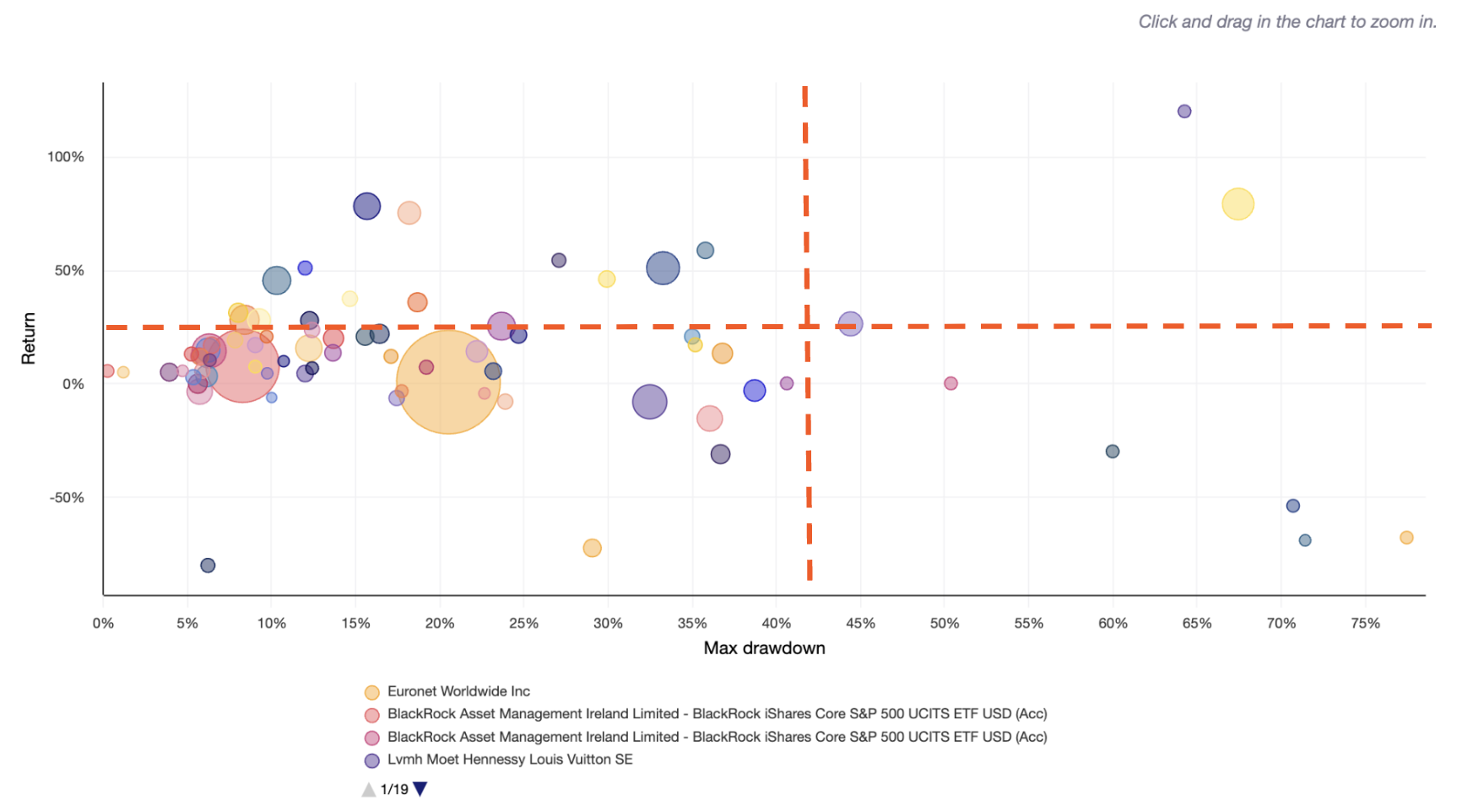
Please note that the dashed lines in the graph are for illustration purposes only.
To interpret the investments' risk and return profiles, the chart can be considered in four quadrants:
Upper Left Quadrant (Low Risk, High Return): Investments in this quadrant have low drawdown risk and high returns, making them the most favourable in terms of risk-adjusted performance. Ideally, a substantial portion of your portfolio is invested here.
Lower Left Quadrant (Low Risk, Low Return): These investments carry low risk but also offer limited returns. While they may not drive significant gains, they provide stability and can act as a hedge against market fluctuations, so maintaining some assets here may be beneficial.
Upper Right Quadrant (High Risk, High Return): Investments here represent growth stocks with both high return potential and high drawdown risk. The proportion of growth stocks in your portfolio depends on your risk tolerance, investment strategy, and goals.
Lower Right Quadrant (High Risk, Low Return): This quadrant contains high-risk, low-return investments, which are typically less desirable due to their high drawdown risk and poor performance. Ideally, none of your investments should fall into this category.
Summary table
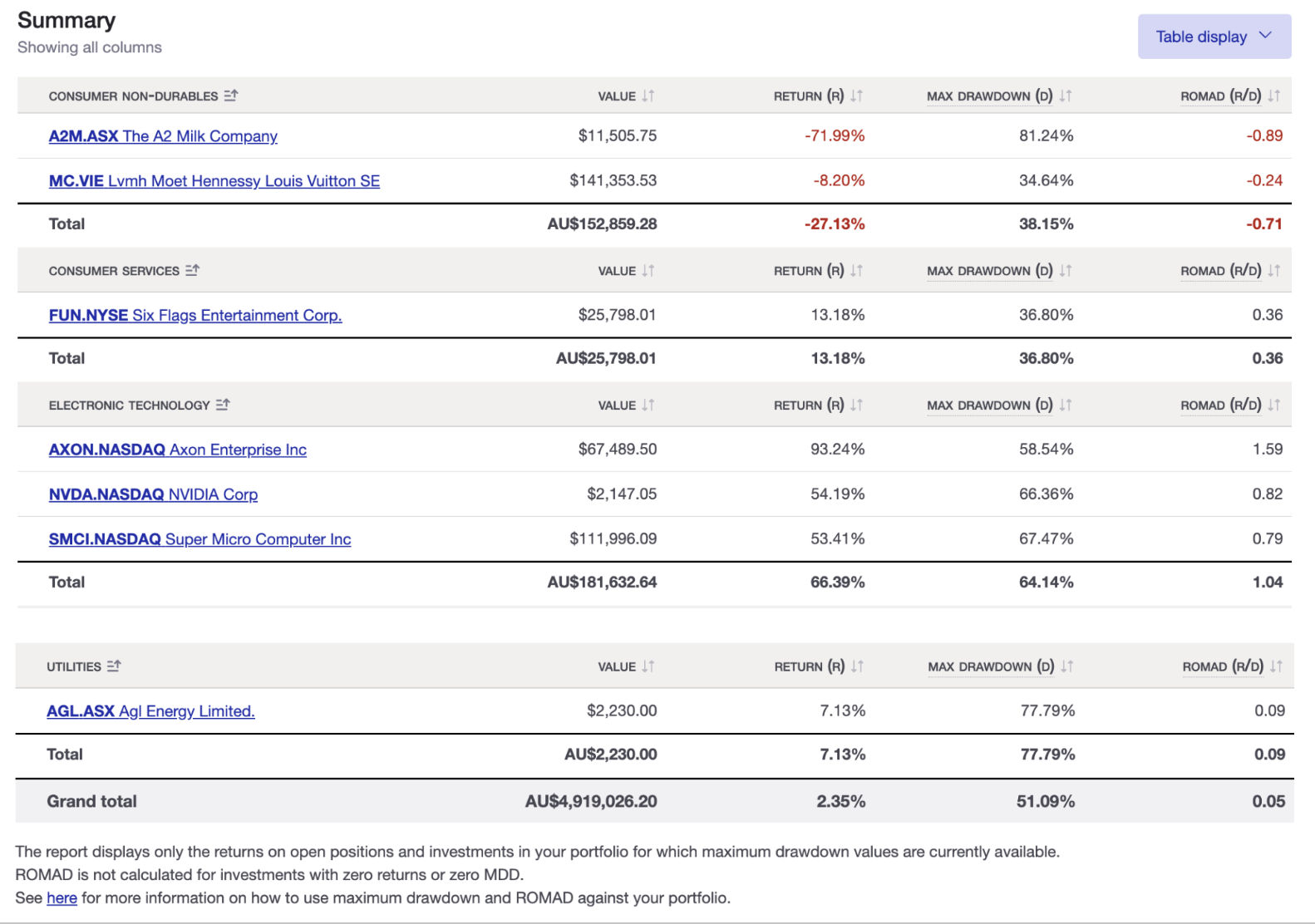
The report summary provides the holding value, total return over the selected drawdown period, MDD percentage, and RoMaD ratio for each investment. If groupings are applied, subtotals for each grouping will be shown, with a grand total at the end of the report.
Other features
Interactive legend:

Click on any individual investments or categories in the legend below the chart exclude or include them. This helps to focus on specific parts of your portfolio by hiding elements that are not relevant to your analysis.
Zoom functionality:

On a desktop, click and drag your mouse over a specific area of the chart to zoom in on that section. This feature is especially useful if many investments are clustered together, allowing for a closer comparison.
FAQs
1 — What is Maximum Drawdown (MDD), and why is it important?
MDD captures the largest loss from peak to trough that an investment has experienced over a given period, illustrating the worst-case loss scenario. This measure helps investors assess the risk of substantial declines.
Here are some examples of how MDD is calculated.
MDD = (Trough Value−Peak Value) ÷ Peak Value
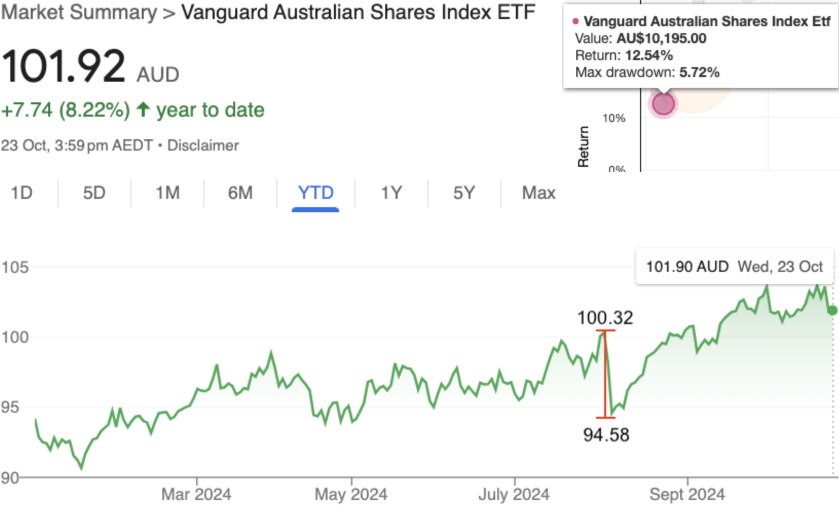
Peak value: $100.32 Trough value: $94.58 (94.58 - 100.32) / 100.32 = -0.057 or 5.72%

Peak value: $22.06 Trough value: $13.00 (13.00 - 22.06) / 22.06 = -0.41069 or 41.07%
2 — What is a ‘good’ ROMAD ratio?
A RoMaD value above 1 suggests the portfolio achieved a return greater than its worst drawdown. However, what qualifies as a “good” RoMaD depends on the investment strategy and market conditions. For instance, conservative portfolios may target RoMaD values of 2 or higher.
3 — How is ROMAD different from other risk metrics like Sharpe Ratio?
MDD reflects the largest peak-to-trough loss an investment has undergone over a specified period, highlighting the worst-case loss scenario and helping investors gauge the risk of substantial declines. While the RoMaD ratio assesses return relative to drawdown risk, the Sharpe ratio measures return against overall volatility. RoMaD is valuable for investors prioritising the avoidance of deep losses, whereas the Sharpe ratio is more suitable for evaluating total risk-adjusted returns.
4 — What timeframe is used for calculating MDD and ROMAD? Can I customise it?
Custom date selection is not yet available. However, additional time periods, such as 6 months or 2 years, could be considered for future updates.
5 — Why does my portfolio show a low ROMAD even though I have positive returns?
A low RoMaD may indicate that returns are insufficient relative to the worst drawdown. Even with positive returns, a substantial drawdown can reduce the RoMaD ratio.
6 — How can I use MDD and ROMAD to make investment decisions?
Investors can leverage these metrics to compare strategies or funds: a higher RoMaD ratio signals stronger risk-adjusted returns, while a lower MDD reflects reduced downside risk. These insights aid in more efficient capital allocation.
7 — How do MDD and ROMAD compare between individual stocks and diversified funds?
Individual stocks typically exhibit higher MDDs due to greater volatility. In contrast, diversified funds often experience lower MDD and higher RoMaD, as diversification helps mitigate the effects of drawdowns.
8 — Why is ROMAD relevant for long-term investors?
Long-term investors can use RoMaD to pinpoint investments that offer strong returns relative to their worst losses. Even with significant drawdowns, a high RoMaD suggests a solid potential for recovery and substantial returns over time.
Note: The guide above provides suggestions for referencing the drawdown risk report in Sharesight and is not intended as a specific product recommendation, nor as tax or financial advice. It should not be relied upon for such purposes.
Last updated 16th December 2025